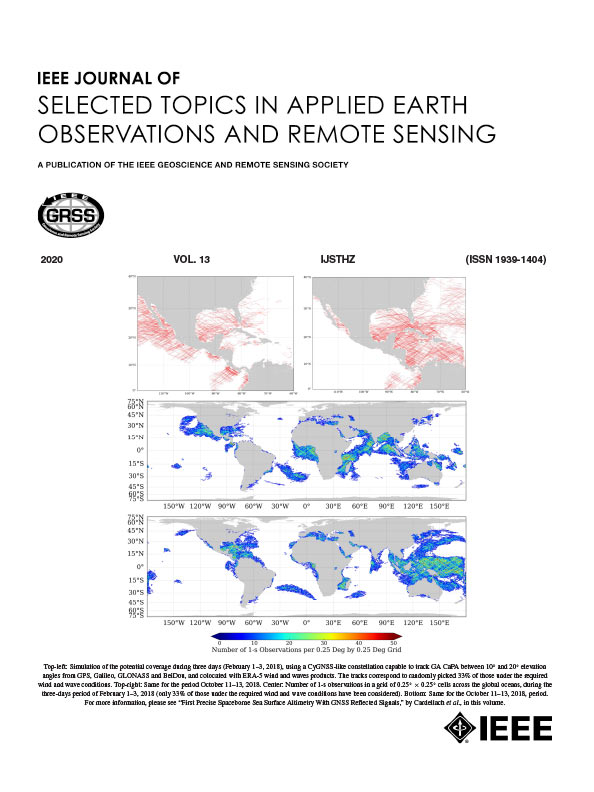Multitask Change-Aware Network and Semisupervised Enhanced Multistep Training for Semantic Change Detection
IF 4.7
2区 地球科学
Q1 ENGINEERING, ELECTRICAL & ELECTRONIC
IEEE Journal of Selected Topics in Applied Earth Observations and Remote Sensing
Pub Date : 2025-03-24
DOI:10.1109/JSTARS.2025.3554272
引用次数: 0
Abstract
Semantic change detection (SCD) aims to find out where and what changes between a pair of co-registered remote sensing images. Compared to binary change detection, which only predicts the location of changes, SCD provides detailed from-to change information, helping to gain a comprehensive understanding and analysis of land cover and land use. SCD is a challenging task due to the complexity of scenes in remote sensing images and the lack of semantic labels in SCD datasets. In this work, we propose a model named Multitask Change-Aware Network (MTCAN) and a Multistep Training (MST) method for land cover semantic change detection in optical remote sensing images. To better identify fine-grained semantic changes, the MTCAN comprises feature aggregation module (FAM), spatial enhancement module (SEM), and change extraction module (CEM). FAM integrates low-level spatial details and high-level semantics from multilevel features, which helps to capture small-sized changes. SEM models long-range correlations and global context, providing global representations in binary change detection and semantic segmentation branches. CEM extracts discriminative change features by calibrating differential features with channel and spatial attention, which helps to accurately locate change areas. MST is designed to overcome the insufficient training caused by the lack of semantic labels, consisting of contrastive loss and iterative self-training. The contrastive loss supervises the semantic segmentation parts with binary change labels. In the self-training process, the trained student model is added to the teacher model ensemble that generates pseudo labels for unlabeled areas, which are then used to train the next student. MTCAN-MST achieves 23.48% SeK on SECOND dataset and 67.74% SeK on Landsat-SCD dataset, outperforming the state-of-the-art methods with lower computational cost.语义变化检测的多任务变化感知网络和半监督增强多步训练
语义变化检测(Semantic Change Detection,SCD)旨在找出一对共存遥感图像之间的变化位置和变化内容。与只能预测变化位置的二元变化检测相比,语义变化检测提供了详细的 "从到 "变化信息,有助于全面了解和分析土地覆被和土地利用情况。由于遥感图像中场景的复杂性以及 SCD 数据集中语义标签的缺乏,SCD 是一项具有挑战性的任务。在这项工作中,我们提出了一个名为 "多任务变化感知网络(MTCAN)"的模型和一种多步训练(MST)方法,用于光学遥感图像中的土地覆被语义变化检测。为了更好地识别细粒度语义变化,MTCAN 由特征聚合模块(FAM)、空间增强模块(SEM)和变化提取模块(CEM)组成。FAM 从多层次特征中整合了低层次空间细节和高层次语义,有助于捕捉微小的变化。SEM 对长距离相关性和全局上下文进行建模,在二进制变化检测和语义分割分支中提供全局表征。CEM 通过校准具有通道和空间注意力的差异特征来提取具有区分性的变化特征,这有助于准确定位变化区域。MST 由对比损失和迭代自我训练组成,旨在克服因缺乏语义标签而导致的训练不足问题。对比损失通过二进制变化标签对语义分割部分进行监督。在自我训练过程中,训练好的学生模型被添加到教师模型集合中,教师模型集合为未标记区域生成伪标签,然后用于训练下一个学生。MTCAN-MST 在 SECOND 数据集上实现了 23.48% 的 SeK,在 Landsat-SCD 数据集上实现了 67.74% 的 SeK,以较低的计算成本超越了最先进的方法。
本文章由计算机程序翻译,如有差异,请以英文原文为准。
求助全文
约1分钟内获得全文
求助全文
来源期刊
CiteScore
9.30
自引率
10.90%
发文量
563
审稿时长
4.7 months
期刊介绍:
The IEEE Journal of Selected Topics in Applied Earth Observations and Remote Sensing addresses the growing field of applications in Earth observations and remote sensing, and also provides a venue for the rapidly expanding special issues that are being sponsored by the IEEE Geosciences and Remote Sensing Society. The journal draws upon the experience of the highly successful “IEEE Transactions on Geoscience and Remote Sensing” and provide a complementary medium for the wide range of topics in applied earth observations. The ‘Applications’ areas encompasses the societal benefit areas of the Global Earth Observations Systems of Systems (GEOSS) program. Through deliberations over two years, ministers from 50 countries agreed to identify nine areas where Earth observation could positively impact the quality of life and health of their respective countries. Some of these are areas not traditionally addressed in the IEEE context. These include biodiversity, health and climate. Yet it is the skill sets of IEEE members, in areas such as observations, communications, computers, signal processing, standards and ocean engineering, that form the technical underpinnings of GEOSS. Thus, the Journal attracts a broad range of interests that serves both present members in new ways and expands the IEEE visibility into new areas.

 求助内容:
求助内容: 应助结果提醒方式:
应助结果提醒方式:


